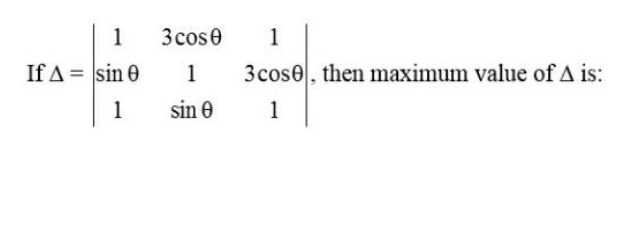Question
Question: If $\Delta = \begin{vmatrix} 1 & 3\cos\theta & 1 \\ \sin\theta & 1 & 3\cos\theta \\ 1 & \sin\theta &...
If Δ=1sinθ13cosθ1sinθ13cosθ1, then maximum value of Δ is:

A
1
B
4
C
9
D
10
Answer
10
Explanation
Solution
To find the maximum value of Δ, we first expand the determinant:
Δ=1(1−3sinθcosθ)−3cosθ(sinθ−3cosθ)+1(sin2θ−1) Δ=1−3sinθcosθ−3sinθcosθ+9cos2θ+sin2θ−1 Δ=sin2θ−6sinθcosθ+9cos2θ Δ=(sinθ−3cosθ)2
To maximize Δ, we need to maximize ∣sinθ−3cosθ∣. The maximum value of Asinθ+Bcosθ is A2+B2. In this case, A=1 and B=−3, so the maximum value of sinθ−3cosθ is 12+(−3)2=10.
Therefore, the maximum value of Δ is (10)2=10.
